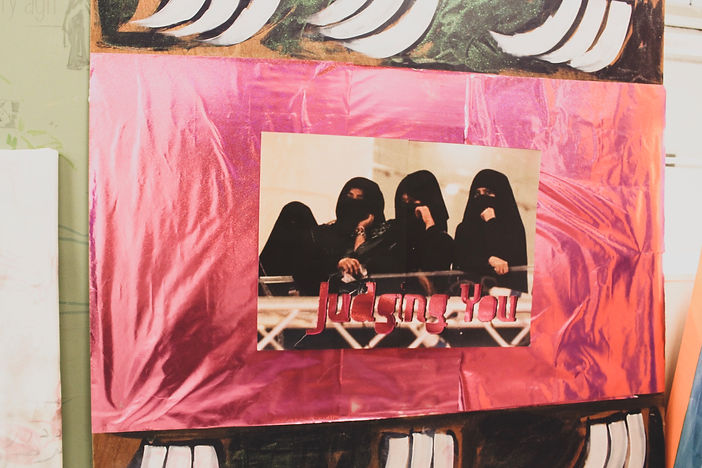ARTIST SPOTLIGHT: ZEINAB SALEH
By Lily Masoud
Her eyes light up as she presents her latest inspiration, a Baati gifted to her mother from relatives in Somalia - except this one has an unusual Apple logo pattern. The traditional dress is normally designed with ornate patterns but with the digital age and globalisation, this Baati is adorned with gold Apple logos found on Mac gadgets.
This is what Zeinab Saleh, a young Somali-British visual artist, explains to me as she strolls through University College London’s busy art school. Growing up, Zeinab said all her art teachers were ethnically white and her knowledge of the art world was Eurocentric, adding, “I think representation is very important, I want to show young people of colour that we can do this too.” Zeinab proudly tells me of her role in the Resistance is Female campaign in New York, a takeover of the advertising streetscape. She noticed there were no Muslim women shown in the ads and decided to photograph one herself, she said, “in this political climate, where the far-right is growing, we need to be represented”.

Zeinab surrounded by her works at University College London's Slade School of Fine Art
The crossover of life in London and the Somali culture Zeinab is exposed to, has impacted her work significantly. She recalls attending a traditional ceremony called shaash saar, a post-wedding party where each family members places patterned fabrics on the bride’s head. Zeinab gestures excitedly whilst describing the ceremony. “Seeing 40 different colours and styles of shaash fabrics at once made me realise our materials are so creative and the iconography stuck to me,” she says.
Being part of the Art Balaayo exhibition - ironically meaning art rubbish in Somali - allowed Zeinab to further explore the culture she is surrounded by. The exhibition included works from female Somali creatives to challenge the mindset of art being looked down on within their community. She says that the exhibition was personal to her, as many people were sceptical of her studying art. “Art isn’t easy but I want to prove that it is valid”, she adds.
As Zeinab adjusts her Nike branded socks, she shows me one of her favourite pieces, a pink canvas with the image of three niqab-clad girls and the words Judging You painted across it. The image of the girls is a typical sight in places like Saudi Arabia and Dubai. “It’s meant to be a funny meme with girls in a mall, just being bitchy,” Zeinab says. “Some audiences read it so politically, they completely miss the humour and can only see the niqab.”

Strong reactions can sometimes lead to racist online trolling and
negative comments - an issue she is all too familiar with. During
Zeinab’s work experience as a curator at the October gallery in
Holborn, she was walking outside of the gallery when a white woman
yelled ‘black dirt’ at her. As an 18-year-old at the time, facing her first
experience of racial abuse, she says the incident made her comprehend how real it is. “I felt sorry for her, she was so bitter but so are many other people, mainly from older generations I think,” she remembers.
With issues of racism and Islamophobia becoming rampant, there is a large audience for Zeinab’s style of work. She believes mainstream platforms like OOMK and Variant Space Art are helping to bring attention to politically driven art like hers. When asked about her future plans, Zeinab says she hopes to keep creating and connecting with the African diaspora, adding, “most of the feedback has been positive so far, alhamdullilah”.
View more of Zeinab's art on her website.
The young artist is attracting more attention for her style of work through social media
A lack of representation made Zeinab turn to online music videos for inspiration, particularly grime music, “I didn’t go to art galleries, I was into the grime scene.” She pulls out one of her creations, a small Nokia 7600 phone with photos of memes stuck meticulously on each button by hand. Phones like these were popular for connecting with people during the golden age of grime in the early 2000s. Zeinab points to each glued on meme to describe her creation. “Using a picture of Oprah expresses my feelings so much better than words, language is so limiting,” Zeinab says. “It’s also a symbol of nostalgia for many of us, you can play snake and call Skepta or Missy Elliot on speed dial.”
"Using a picture of Oprah expresses my feelingsso much better than words, language is so limiting"
ZEINAB SALEH




